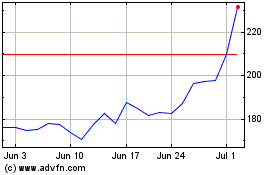Fatal Tesla Crash in Texas Believed to Be Driverless -- 3rd Update
April 18 2021 - 6:22PM
Dow Jones News
By Rebecca Elliott
Two men died after a Tesla vehicle that authorities believe was
operating without anyone in the driver's seat crashed into a tree
Saturday night north of Houston.
One of the men was in the front passenger's seat and the other
was in the back seat of the Tesla, which was traveling at high
speed along a curve before it hit a tree around 11:25 p.m. local
time, Harris County Precinct 4 Constable Mark Herman said in an
interview.
"Our preliminary investigation is determining -- but it's not
complete yet -- that there was no one at the wheel of that
vehicle," the constable said. "We're almost 99.9% sure."
It took emergency responders about four hours and roughly 32,000
gallons of water to put out the fire that engulfed the electric
vehicle, Constable Herman said. High-voltage batteries like the
ones used in Teslas can reignite after being damaged, even after
firefighters have extinguished a fire, according to the National
Transportation Safety Board.
As of Sunday, authorities still were investigating whether the
front passenger airbag deployed and whether the vehicle's advanced
driver-assistance system was enabled at the time of the crash.
Neither Tesla Inc. nor the National Highway Traffic Safety
Administration, the top U.S. auto safety regulator, responded to
requests for comment.
Tesla tells drivers using its advanced driver-assistance system,
known as Autopilot, to pay attention to the road and be prepared to
take control of the vehicle. It also says that driving with the
Autopilot system engaged is safer than doing so without it.
Tesla also has been rolling out an upgraded suite of assistance
features on a limited basis, a system it calls "full
self-driving."
"Autopilot and full self-driving capability are intended for use
with a fully attentive driver, who has their hands on the wheel and
is prepared to take over at any moment," Tesla says on its website,
noting that the features don't make the vehicle autonomous.
Some safety advocates have said that the company doesn't do
enough to keep drivers from depending too much on the features or
using them in situations for which they aren't designed. They also
have criticized the company for the language it uses to describe
its features, saying that terms such as "Autopilot" and "full
self-driving" risk giving drivers a false sense of the vehicle's
abilities.
"They are intentionally, foreseeably creating unnecessary risks
to the public," said Jason Levine, executive director for the
Washington, D.C.-based Center for Auto Safety.
Tesla has told federal officials that it doesn't believe it
needs to limit where drivers are allowed to use its assistance
system because the vehicle is under the driver's control.
NHTSA doesn't have any rules on the books prescribing how
companies must monitor driver engagement, something the NTSB, which
issues safety recommendations, has criticized, saying that it puts
people at risk.
NHTSA has said that it is evaluating potential next steps to
ensure driver safety.
Autopilot has come under heightened scrutiny in recent months
after a series of crashes involving Tesla vehicles. NHTSA has
launched more than two dozen advanced driver-assistance-related
investigations into crashes involving Tesla vehicles.
Ben Foldy contributed to this article.
Write to Rebecca Elliott at rebecca.elliott@wsj.com
(END) Dow Jones Newswires
April 18, 2021 18:07 ET (22:07 GMT)
Copyright (c) 2021 Dow Jones & Company, Inc.
Tesla (NASDAQ:TSLA)
Historical Stock Chart
From Aug 2024 to Sep 2024

Tesla (NASDAQ:TSLA)
Historical Stock Chart
From Sep 2023 to Sep 2024
